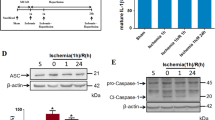Abstract
The inducible or “immunological” isoform of nitric oxide synthase (iNOS) is induced in many cell types by inflammatory stimuli and synthesizes toxic amounts of NO. In rodent models of focal cerebral ischemia, iNOS is expressed in neutrophils invading the injured brain and in local blood vessels. Studies with iNOS inhibitors and iNOS null mice indicate that NO produced by iNOS contributes to ischemic brain injury. In the present study, we sought to determine whether iNOS is also expressed in the human brain after ischemic stroke. Studies were conducted using immunohistochemistry on autopsy brains with neuropathological evidence of acute cerebral infarction. iNOS immunoreactivity was observed in neutrophils infiltrating the ischemic brain and in blood vessels within the ischemic territory. iNOS-positive cells also were immunoreactive for nitrotyrosine, reflecting protein nitration by NO-derived peroxynitrite and nitrites. iNOS or nitrotyrosine immunoreactivity was not detected outside the region of the infarct. These observations provide evidence that iNOS is expressed in the human brain after ischemic infarction and support the hypothesis that iNOS inhibitors may be useful in the treatment of ischemic stroke in humans.
Similar content being viewed by others
Author information
Authors and Affiliations
Additional information
Received: 8 June 1998 / Revised, accepted: 23 September 1998
Rights and permissions
About this article
Cite this article
Forster, C., Clark, H., Ross, M. et al. Inducible nitric oxide synthase expression in human cerebral infarcts. Acta Neuropathol 97, 215–220 (1999). https://doi.org/10.1007/s004010050977
Issue Date:
DOI: https://doi.org/10.1007/s004010050977




